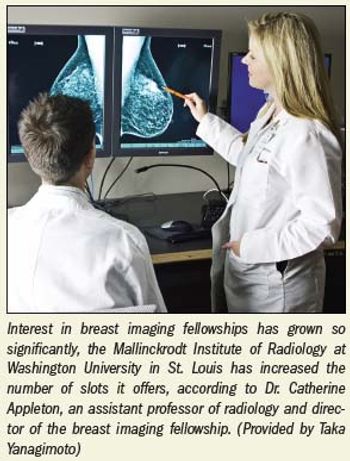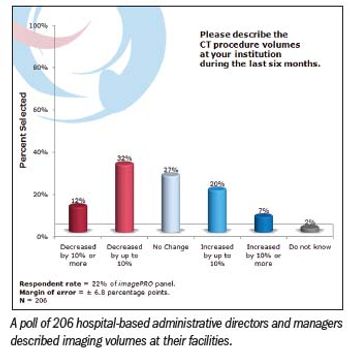
With all the doom and gloom surrounding mammography-lower reimbursement, high threat of malpractice lawsuits-it's easy to assume residents would shy away from the field.
Now there’s proof after a day of interpreting images radiologists are less accurate, more tired, unable to focus, and experience eyestrain compared to earlier in the day. A study in the Journal of the American College of Radiology compared the ability of radiologists and residents to read bone exams earlier in the day to later in the day.

With all the doom and gloom surrounding mammography-lower reimbursement, high threat of malpractice lawsuits-it's easy to assume residents would shy away from the field.

Business consultant Pat Kroken discusses the need to batten down the hatches before provisions of the healthcare reform bill blow in next year. She suggests ways to improve internal billing and collection processes and find lost money.

Before you get on that plane, check the frequent flyers’ round trip special from Rocky Flats Gear: Purchase two pair of men’s radiation-shielding briefs and two pair of women’s briefs and get two pair of bra inserts for free.

A great deal of our time has been spent trying to find ways to make ourselves more efficient. One of those ways we began looking at several years ago was reducing the time we spend in nonbillable activities and in performing procedures that our hospital affiliation requires but that are relatively time-intensive for their reimbursement. To do this, we looked into hiring physician extenders.

A growing body of evidence supports the use of CT colonography for colon cancer screening and a U.S. panel should reverse its decision to not endorse the procedure, according to the CT Colonography Coalition.

Everybody loves to read about the future. We may not be too keen to admit it openly, but we all feel varying degrees of fear and apprehension about what lies around the corner.

CMS codes on radiologic guidance for needle placement is confusing and implementation varies by medical society and payer.

With concerns about x-ray exposure mushrooming and anecdotes circulating about patients balking at exams involving ionizing radiation despite a commanding medical need for those exams, it’s not surprising to hear of documentation that the number of procedures for any x-ray related modality has gone down. Such was the case earlier this week, when the IMV Medical Information Division released the results of a survey that studies performed using radiography/fluoroscopy equipment at hospitals with more than 150 beds dropped about 9% from 2004 to 2009.

For the medical profession to continue to grow and thrive, trainees must be given meaningful opportunities to actively care for patients. New blogger Dr. Arun Krishnaraj discusses how that’s happening now and how it can be made better, for patients as well as doctors.

When we ask radiologists about their collections, they usually say, “We capture most of our revenue, but you know how radiology is, you can’t collect it all.”

What is billed as an alliance may become the first step in a move that could position Virtual Radiologic as a national radiology group practice. The alliance will bring that company and S&D Medical into a workflow and technology partnership beginning Oct. 1.

It may turn out to be one of those “who would ever have thought that would happen?” kind of things. But in the world of U.S. politics, it might be exactly what’s needed.

Too often radiologists are far removed from the billing and collections process. Giving them a better understanding of the process, and the role their reports play in it, can improve collections and streamline the work that takes place in the back office.

Overutilization of medical imaging services exposes patients to unnecessary radiation and adds to healthcare costs, according to a report.

Three U.S. senators have joined the debate over the safety of x-ray based whole-body airport scanners, asking federal officials to review scanner health effects on travelers and airport and airline personnel.

The vacancy rate for radiographers has continued to decline in recent years and is now at 2.1%, according to a staffing survey recently conducted by the American Society of Radiologic Technologists.

This is the third and final article in a series reviewing why and how radiology practices set themselves up to lose their long-held professional services agreements. What steps groups can take to turn an adversarial relationship to a collaborative partnership is the subject of this third article. Included is a challenge to change how we conduct business, with the goal of long-term success for everyone involved.

Is it time to add another physician? We have asked this question quite a bit recently, especially on busy days, which seem to be happening more often. Because adding another full-time physician would be expensive-especially if we guessed wrong-we wanted to make sure that it really was time to expand.

To paraphrase Harry Truman, what virtual colonoscopy needs is a one-handed analyst. This was made clear earlier this week in the share price activity of iCAD , which leaped about 18% on news that the FDA had cleared the company’s VeraLook software for interpreting virtual colonoscopy exams. The next day the stock gave back about as much ground as it had gained.

A number of radiology practices were able to significantly reduce the radiation dose associated with multislice CT scans by participating in a one-day dose optimization workshop provided by the Royal Australian and New Zealand College of Radiologists (RANZCR) and supported by the local state health department, according to a study in the August issue of the Journal of the American College of Radiology.

Are you ready to engage your partners in a serious conversation about aligning your practice around shared goals and challenges? If so, here is a series of steps you can take that move the practice in that direction.

Proposed new credentialing requirements could make it more difficult for hospitals to contract with teleradiologists to provide night and weekend call, a legal analysis concludes.

All across the country high-tech imaging volumes are flat or declining compared with last year.

Until we broke down the numbers, we didn’t realize that our practice’s overnight call coverage cost had increased by 200% in just three years. We had to take a close look at the root causes before we could agree on the solution.

Medical acronyms are intended to boost efficiency. The advantages of brevity should be weighed against the possibility of crypticness (making the communication harder for others to understand) and ambiguity (having more than one possible interpretation). In other words, a smart communicator uses good shortcuts but makes sure that other people will understand what he or she means.